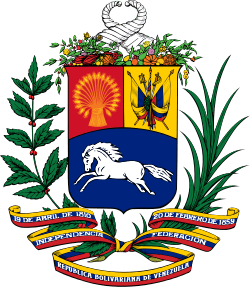Agriculture in Venezuela

Agriculture in Venezuela has a much smaller share of the economy than in any other Latin American country. From the discovery of oil in Venezuela in the early twentieth century to the 1940s, the importance of agriculture declined rapidly, and with the beginning of large-scale industrial development in the 1940s, agriculture and land reform was largely neglected by successive governments (although a 1960 land reform law did see 200,000 families receive land, largely in the early 1960s). The country imports most of its food, mainly from Colombia and the United States.[1] Since 1999, under the Bolivarian Revolution of President Hugo Chávez, agriculture has had a somewhat higher priority.
History
Prior to the 1950s and the initiation of large-scale oil exports, agriculture, fishing, and forestry were central to the Venezuelan economy, producing more than half the gross domestic product (GDP). As late as the 1930s, agriculture still provided 22 percent of GDP and occupied 60 percent of the labor force. As the petrochemical industry expanded rapidly in the 1970s and 1980s, however, the proportion of the labor force in agriculture dropped from one-fifth to about one-tenth. By 1988 agriculture contributed only 5.9 percent of GDP, employed 13 percent of the labor force, and furnished barely 1 percent of total exports. Agriculture has continued to decline, accounting for about 5 percent of GDP and 10 percent of employment in 2004.[1] According to a 1997 government survey, 3.4m hectares of land are suitable for farming (and a further 17.1m hectares suitable for pasture) - but only 0.7m hectares were employed in grain production.[2]
Venezuela saw several attempts at land reform before 1998. During the brief first period of democracy (El Trienio Adeco, 1945–48), the Democratic Action government redistributed land which it said had been gained illicitly by members of previous governments,[3] and in mid-1948 it enacted an agrarian reform law.[3] Most of the land redistributed in this way was returned to its previous owners during the 1948-58 dictatorship of Marcos Pérez Jiménez.[3] After the 1958 restoration of democracy, a new land reform law was enacted in March 1960,[3] with reform in the early 1960s concentrated in the northeastern states of Miranda, Aragua and Carabobo, and coming largely from expropriated private landholdings.[3] The reform was accompanied by a considerable increase in agricultural production.[3] Ultimately the reform saw about 200,000 families receive transfers of land, largely in the early 1960s.[4]
Bolivarian Revolution
Venezuela's present-day agriculture is characterized by inefficiency and low investment, with 70 percent of agricultural land owned by 3 percent of agricultural proprietors (one of the highest levels of land concentration in Latin America). According to the Land and Agricultural Reform Law of 2001 (see Mission Zamora), public and private land deemed to be illegally held or unproductive is to be redistributed.[1] From 1999 to 2006, 130 landless workers were assassinated by sicarios paid by opponents to the reform.[5] As of January 2009, the Venezuelan government had redistributed nearly 2.7 million hectares of idle land (6.6 million acres—nearly 1/3 of the latifundio land existing prior to 1998) to 180,000 landless peasant families.[6]
A new Bolivarian Mission, Mission Vuelta al Campo was announced in 2005; it seeks to encourage impoverished and unemployed urban Venezuelans to willingly return to the countryside. This has involved using land recovered from private owners where ownership could not be demonstrated, as well as nationalisation. For example in 2008 the government expropriated El Frio, a 63,000 hectare estate in Apure (larger than the tourist island of Isla Margarita), as its owners (reputed to include Nelson Rockefeller) could not demonstrate legal land title.[7] The Venezuelan government has also employed foreign expertise to develop Venezuela's agricultural potential, for example by working with Vietnamese agronomists to develop planting techniques and rice seed hybrids appropriate to Venezuelan agricultural conditions.[8] The land reform program has nevertheless been the subject of criticism from a variety of sources, with farmers said to be lacking sufficient government support,[9] particularly in the case of urban residents moving to the countryside to develop farming cooperatives.
The government has confiscated and expropriated much of the industry. State intervention has seriously damaged the agricultural sector, and Venezuela imports most of its food. There are persistent shortages of common foodstuffs.[10][11] The government blames "hoarders" and "speculators" for food shortages.[12]
References
- ↑ 1.0 1.1 1.2 Venezuela country profile. Library of Congress Federal Research Division (March 2005). This article incorporates text from this source, which is in the public domain.
- ↑ USDA, Venezuela: Agricultural Overview, accessed 21 May 2009
- ↑ 3.0 3.1 3.2 3.3 3.4 3.5 Alexander, Robert. "Nature and Progress of Agrarian Reform in Latin America." The Journal of Economic History. Vol. 23, No. 4 (Dec., 1963), pp 559-573.
- ↑ Gregory Wilpert, "Land for people not profit in Venezuela", in Peter Rosset, Raj Patel, Michael Courville, Land Research Action Network (2006), Promised land: competing visions of agrarian reform. Food First Books. p251
- ↑ Maurice Lemoine, Venezuela: the promise of land for the people, Le Monde diplomatique, October 2003 (English)/(French)/(Portuguese)/(Esperanto)
- ↑ Christina Schiavoni and William Camacaro. "The Venezuelan Effort to Build a New Food and Agriculture System". Monthly Review.
- ↑ Venezuelanalysis, 8 September 2008, Venezuelan Government Turns Large Estates Into Socialist Production Centers
- ↑ Venezuelanalysis, 15 May 2009, Venezuela Uses Recovered Land to Plant Rice with Vietnamese Assistance
- ↑ In Venezuela, Land Redistribution Program Backfires by Juan Forero, NPR, July 15, 2009
- ↑ "Venezuelan socialism: Food fight". The Economist. 12 June 2010. Retrieved 18 February 2013.
- ↑ "Venezuela Food Shortages Reveal Potential Problems During Chavez Absence". Huffington Post. 15 January 2013. Retrieved 18 February 2013.
- ↑ "Venezuela’s economy: Out of stock". The Economist. 9 February 2013. Retrieved 19 February 2013.
External links
| Wikimedia Commons has media related to Agriculture in Venezuela. |

